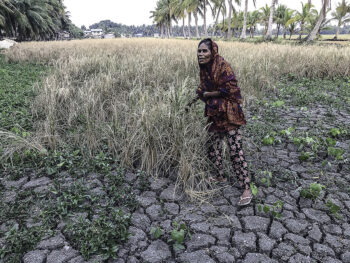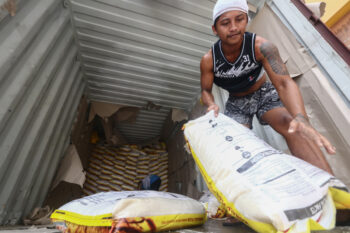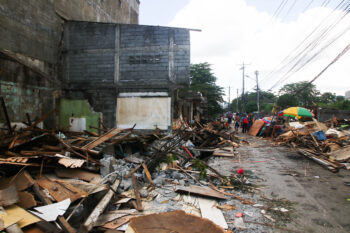by Kristian Herbolzheimer and Emma Leslie / Conciliation Resources
After the signing of the Annex on Normalization in Kuala Lumpur, the Malaysian facilitator referred to the nearly completed comprehensive peace agreement as the Philippines’ second major contribution to the world, after People Power in 1986. In his opinion, the Comprehensive Agreement on the Bangsamoro is the best autonomy provision in the whole region, and will inspire settlement of identity-based conflicts elsewhere.
This new Mindanao peace agreement became somewhat of a surprise headline in international media, among news about impasse in peace talks on Syria; bombs in Egypt; standoff in Ukraine; war in South Sudan; and a new massacre of Muslims in Myanmar. Mindanao became a sign of hope in a troubled world. The Philippines is making a difference.
Peace agreements are indeed rare. It is not exaggerated to affirm that the agreement on the Bangsamoro is the most significant in the world since the Comprehensive Peace Accord between the Government of Nepal and the Unified Communist Party of Nepal (Maoist) in 2006. No wonder, therefore, that the world is watching and taking note. There is no recipe to building peace, which is why it is so important to pay attention to lessons learned.
Learning on the go: protecting the negotiations
Covered by a ceasefire agreement, the Philippin Government (GPH) and the Moro Islamic Liberation Front (MILF) have been talking for almost 17 years. A quite unique feature in itself, and a reminder for others that a ceasefire does not necessarily indicate weakness.
Early on the MILF was already clear that the solution to the Moro problem was not in the battlefield, and that talking was a far more powerful tool than killing.
The Armed Forces would find out themselves the futility of a military approach. After effectively defeating the MILF in 2000 and 2003, they learned that a political problem needs a political solution, and cannot be addressed with guns.
Indeed, the fallout after the frustrated signing of the MoA-AD in 2008 led to a massive humanitarian disaster, but mainstream MILF and AFP had built enough mutual trust to avoid a third episode of all out war.
The three major breakdowns of the ceasefire led to a gradual sophistication of the negotiation mechanism. Each hurdle led to a new building block in the support architecture to prevent new crisis. In 2001 the parties asked the Malaysian government to host and facilitate the peace negotiations. In 2004 they agreed to an International Monitoring Team to verify the ceasefire. And in 2009 the IMT added two components: human rights and humanitarian; and civilian protection.
The MoA-AD crisis also produced an International Contact Group (ICG), to witness the negotiations and assist the parties and the facilitator. The Government and the MILF agreed to a hybrid Contact Group composed of four states – Japan, the United Kingdom, Turkey and Saudi Arabia – and four international NGOs –The Asia Foundation, Muhammadiyah, the Centre for Humanitarian Dialogue, and Conciliation Resources. This hybrid composition was a compromise to the MILF’s eagerness to internationalise the peace talks and the Government’s aversion to external interference in domestic affairs. It also reflects a mix of Western, Asian and Muslim countries and organizations.
Most peace negotiations in the world have some sort of international support mechanism. But the Mindanao ICG is the only group that incorporates NGOs along diplomats. Thus, another contribution the Philippines offers to the ever-developing field of international peacemaking.
Learning from the past: the challenge of implementation, the value of inclusion
Back in 1996 the Government already signed a Final Peace Agreement with the Moro National Liberation Front (MNLF). But as in so many other peace processes, the implementation phase was poorly devised.
Maybe the most relevant improvement of the current negotiations is a clear roadmap for implementation, with sophisticated support architecture for issues such as decommissioning, policing, and transitional justice. A Third Party Monitoring Team (TPMT) will assess developments and eventually certify an Exit Agreement that will complete the implementation phase, ideally by 2016.
The Supreme Court ruling on the MoA-AD in 2008 brought another lesson. The justices reminded the parties of the importance of transparency and inclusivity. All stakeholders needed to be informed and consulted prior to decisions being taken at the negotiating table. Despite the setback for the process, in the long run this ruling triggered one of the most democratic peace processes of the world. Both panels have engaged in countless consultations with mayors, governors, legislators, and leaders from the religious, academic, business, and security sectors. The outcome of the negotiations cannot take anyone by surprise any more.
Learning from civil society
The positive developments in the peace process owe a lot to civil society organizations (CSOs). They have developed concepts –like the tri-people- the have created innovative mechanisms –like civilian monitoring and protection- they have normalized inter-faith dialogue, they have institutionalized peace days, peace weeks and peace months.
NGOs have permanent access to both negotiating panels; some members have eventually even joined the negotiating teams, a recognition to their skills and talent.
CSOs are currently conducting hundreds of consultations to inform all sectors and communities about the developments and the challenges ahead, and to document hopes, fears and recommendations for the forthcoming Bangsamoro Basic Law.
Indigenous peoples, who have historically felt marginalized by both settlers and Muslims, are increasingly asserting their rights, articulating their vision of coexistence in the future Bangsamoro.
Both panels have incorporated women in their negotiating teams, and paid special attention to gender-responsive criteria when drafting the multiple partial agreements. The Comprehensive Agreement on the Bangsamoro is probably the first peace agreement ever to be signed by a woman as chair of a negotiating panel.
Learning from the tragedy
Despite all innovations and lessons learned, the Zamboanga tragedy last September is a reminder of how wrong things can go. The physical consequences are devastating: hundreds of dead, thousands of houses destroyed, hundred thousand people displaced. The less visible wounds will be difficult to heal: the trauma of those who suffered the violence; the renewed mistrust between ethnic, religious and political sectors; the frustration among peace advocates for not having been able to prevent and manage the situation differently.
Looking back it might be safe to suggest that in Zamboanga no one won, but everyone lost. Fortunately the vast majority of people in the Bangsamoro and its neighbouring cities and provinces are fully aware that violence only triggers more violence. And this is in itself maybe the most important lesson of the Mindanao peace process. Once violence looses its appeal, there is a better future for all, a future of coexistence that is based on trust and equal opportunities.
The value of compromise. A shared achievement.
Negotiation is an exercise of give and take, of finding common ground, of identifying a solution where everyone wins as much as possible and looses as little as possible. Negotiations is an exercise of compromise.
Over the course of the negotiations MILF abandoned its claim for independence and the Government of the Philippines accepted significant devolution. Both parties thus becoming partners for peace and therefore equally interested in a successful implementation of their milestone agreement. They have a shared understanding that “what is good for the Bangsamoro is good for the Philippines”.
The completion of the GPH-MILF peace negotiation is a collective victory. It is important to pay tribute to all those who throughout the years have joined the peace panels. And to all the people in the grassroots who have persevered and nurtured the dialogue that has sustained the process even in its most difficult moments. All these courageous women and men are a source of inspiration for the whole country. They are now a reference also for the rest of the world. (MindaViews is the opinion section of MindaNews. PEACETALK is open to anyone who wishes to share his/her reflections on the peace processes. Kristian Herbolzheimer and Emma Leslie are both members of the International Contact Group in the GPH-MILF peace process. Herbolzheimer is Director of the Philippines Programme at Conciliation Resources while Leslie is Executive Director, Centre for Peace and Conflict Studies in Siem Reap, Cambodia and Philippines Programme Associate also at Conciliation Resources)






